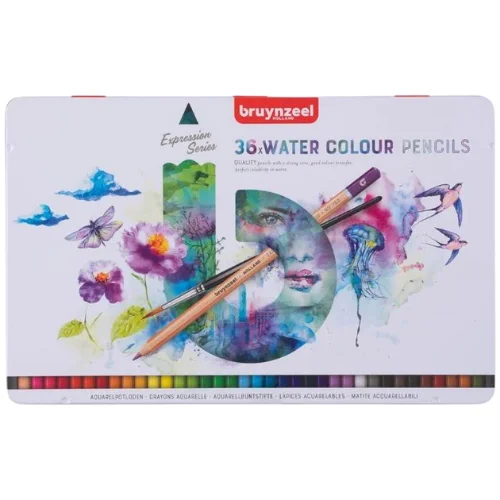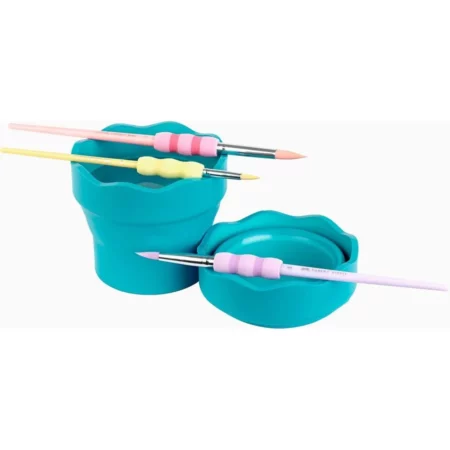36’s Bruynzeel Expression Aquarelle Pencils Tin
R695.00
- Bruynzeel Expression Aquarelle Pencils have an outstanding colour transfer and tinting strength, making it a joy to work with them.
- Manufactured with quality pigments for good colour transfer and complete solubility in water.
- Bruynzeel Expression Aquarelle Pencils can be applied both wet and dry.
- 36 high-quality water colour pencils with a strong, thick 2.9 mm core.
- Bruynzeel pencils have a hexagonal shape and will not roll away.
- They also have a matte finish to grip the pencil with ease.
- The ends of each pencil are colour coded for easy selection.
Change the quantity above using the arrows (shown on hover) or manually input your desired amount.
Drawing inspiration from the masterpieces housed in the renowned Rijksmuseum of the Netherlands, Bruynzeel presents a set of coloured pencils that beckon artists to channel the spirit of Van Gogh, Vermeer, and Rembrandt. These pencils transcend the ordinary, offering an exceptional colour transfer and tinting strength that elevates the creative process. Crafted with quality pigments to ensure optimal colour transfer and solubility in water, the Bruynzeel Expression Aquarelle Pencils stand out for their versatility. Whether applied wet or dry, these pencils deliver remarkable results, and a complementary paintbrush is included for added convenience. With a robust 2.9 mm core, 12 high-quality watercolour pencils empower artists to express their vision with precision. The hexagonal shape prevents rolling and provides a comfortable grip, further enhanced by the matte finish. To streamline the selection process, each pencil features colour-coded ends, allowing artists to effortlessly choose the perfect shade. Bruynzeel has seamlessly blended tradition and innovation to bring forth a set of watercolour pencils that beckon artists to create with the timeless elegance of the old masters.
Watercolour pencils offer a unique medium combining drawing and painting. They provide the best of both worlds, similar to coloured pencils but with different behavior when water is added. Coloured pencil pigment is held by a waxy or oil-based binder, while watercolor pencils have a water-soluble binder. The pencil’s encased medium allows artists to create detailed and delicate marks that may be challenging with a brush.
How to Use Watercolour Pencils:
Activation with Water: Watercolour pencils are designed to be used with water, which can be applied with a soft brush after making marks with the pencil. This process is called activation. Once the material has been “activated”, it behaves like watercolour.
Typically, water is applied with a brush, but sponges and other tools can be used as well. Nylon brushes work well for this, but natural hair brushes work too. Bristle brushes are typically used for heavier bodied media like oils or acrylics, so it may be best not to use them with watercolour.
Layering and Mixing Colours: Watercolour pencils can be mixed, mostly through layering. To mix colours, apply one colour and then layer an application of a second colour over the top or right next to the first colour. Then, activate the area with water. The colours will mix together. To produce additional depth in the colour and additional mixing, allow the first layer to dry completely. Then you can repeat the process with another round of mixed colours over the top of the dried area. Remember, layering too many colours can ‘muddy’ the colour. So be sure to limit your layers to avoid this. You can also have a test sheet of paper on hand to test your mixtures prior to applying them to your finished work.
Experimentation: Experiment with various techniques, such as applying the pencil directly to a saturated area for unique effects.
Taking Colour from the Pencil Tip: You aren’t limited to applying the pencil to the surface. You can also take the pigment directly from the tip of the pencil with a brush loaded with water. You can then apply the colour directly to the surface with a brush, just like with traditional watercolours. This technique often results in a lighter and less intense application of colour.
Surfaces: Watercolour pencils should be applied to watercolour paper or a heavy board such as illustration board. As water is applied, thinner papers will tend to buckle or even tear.
Surface Texture: Cold press watercolour papers with heavier texture or “tooth” are recommended, but artists may choose smoother surfaces (hot press watercolour paper) based on preference.





